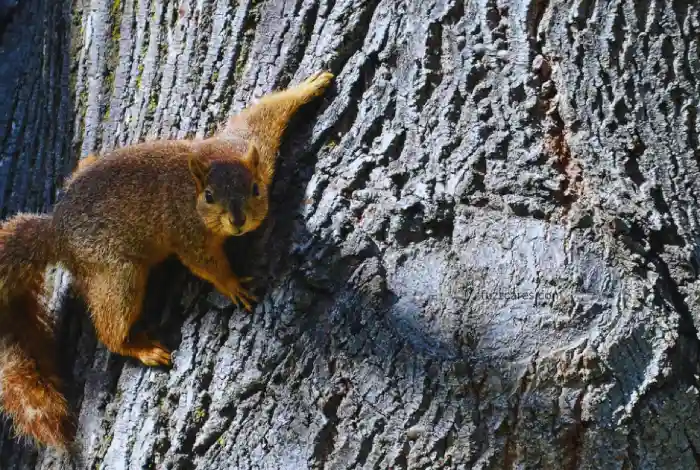While it seems impossible for a small creature like a squirrel to endure such a high fall without any injury, nature has equipped these agile rodents with astonishing abilities. Squirrels are well-known for their acrobatic skills, leaping from treetops and navigating challenging environments.
But can they truly defy gravity and survive a fall from such great heights?
In this article, we will explore the adaptations and natural instincts that allow squirrels to conquer the skies and come out unscathed from seemingly impossible situations.
Let’s dive into the world of these gravity-defying daredevils and uncover the truth about their survival skills. Let’s find out.
Can a Squirrel Survive a 200 ft Drop?
While squirrels are incredibly agile and adept at navigating trees and heights, a 200-foot drop would likely pose a significant danger to their well-being.
The physics of such a fall would subject them to high forces, and their small size and lightweight bodies make them susceptible to injuries upon impact. Squirrels are not equipped with any specialized adaptations for surviving falls from extreme heights, unlike some other animals like flying squirrels or certain birds.
Squirrel Adaptations
To assess a squirrel’s potential survival, it’s important to understand the unique adaptations that make these creatures so remarkable.
Squirrels possess several physical and behavioral characteristics that allow them to thrive in their arboreal habitats.
Let’s take a closer look at these adaptations:
Agility and Balance
They have exceptional balance and coordination. Their long, bushy tails act as a natural counterbalance, enabling them to make precise jumps and landings. Their sharp claws provide them with a firm grip on various surfaces.
Lightweight Body Structure
Squirrels have slender bodies with lightweight bones, which help them maneuver swiftly through trees. Their reduced body weight reduces the impact on their bodies when landing from heights.
Aerial Righting Reflex
When a squirrel falls, it instinctively spreads its limbs and adjusts its body position in mid-air. This reflex helps them orient themselves to land on their feet and absorb the impact more effectively.
Fur and Padding
Squirrels have thick fur that helps protect them from superficial injuries during falls. They have a layer of fat to provide padding and absorb some of the impact.
The Impact of a 200 ft Drop
A 200 ft fall is a significant distance, and it’s natural to assume that any creature, including squirrels, would have a slim chance of surviving such a drop.
Acceleration
During the initial phase of the fall, the squirrel would accelerate due to the force of gravity. The acceleration would gradually increase until it reaches its maximum velocity, known as terminal velocity.
Terminal Velocity
Terminal velocity is the point where the force of gravity pulling the squirrel downward is balanced by the resistance from the air pushing against it. For a squirrel, the terminal velocity is estimated to be around 60 mph (97 km/h). At this speed, the squirrel would stop accelerating and maintain a relatively constant velocity throughout the fall.
Impact
When reaching the ground, the squirrel would experience a sudden stop as it collides with the surface. The impact force would depend on various factors such as the squirrel’s mass, body position, and the nature of the landing surface.
Squirrel Survival Related Article: Why Don’t Squirrels Get Electrocuted
Survival Chances
Now that we have a better understanding of the mechanics involved, let’s assess the survival chances of a squirrel after a 200 ft drop:
Fatal Injuries
In most cases, a fall from such a height would likely result in fatal injuries for a squirrel. The impact force generated when hitting the ground could cause internal injuries, fractures, or even death.
Body Position
The squirrel’s chances of survival would depend on how it positions its body during the fall. If it manages to perform an aerial righting reflex and land on its feet, it may have a higher chance of surviving compared to falling in an unfavorable position.
Landing Surface
The type of surface the squirrel lands on also plays a crucial role. A soft and cushioned landing surface, such as a thick layer of leaves or grass, would help absorb some of the impact and increase the chances of survival.
Height Variations
It’s important to note that the squirrel’s chances of survival decrease significantly as the height of the fall increases. While they are highly adapted to survive falls from tree heights, extremely high drops like 200 ft would greatly diminish their chances of walking away unscathed.
Factors Affecting Survival
The physical aspects discussed, there are other factors that could influence a squirrel’s survival after a fall from any height:
Age and Health
Young squirrels or those in poor health may be less likely to survive a fall compared to healthy adult squirrels. Their bodies may be less resilient and unable to withstand the impact forces.
Luck and Random Factors
Survival can also be influenced by luck and random variables. Factors such as wind currents, branch placement, and the squirrel’s ability to grab hold of something mid-fall could potentially impact the outcome.
Adaptability
Squirrels are known for their adaptability, and some studies have shown their remarkable ability to recover from significant injuries. While survival may seem unlikely, squirrels have been known to defy the odds and recover from seemingly dire situations.
An Unpredictable Scenario
It’s important to remember that a 200 ft drop for a squirrel is an extremely rare and unpredictable scenario.
Squirrels are naturally adept at navigating their surroundings and rarely find themselves in situations where they would need to survive such a fall.
Their impressive adaptations are finely tuned for tree-dwelling, where falls from significant heights are generally a rarity.
How Far Can a Squirrel Really Fall?
Frequently Asked Questions
Can a squirrel survive a 200 ft drop?
Yes, squirrels have certain adaptations that enable them to survive falls from significant heights.
How far can a squirrel fall without getting hurt?
Squirrels can typically survive falls from heights of up to 30 meters (approximately 98 feet) due to their lightweight bodies and ability to glide.
Can a squirrel survive a fall from a plane?
No, a squirrel cannot survive a fall from a plane as the altitude and speed would be fatal.
Can squirrels survive a fall from any height?
Squirrels have limits. Falls from extreme heights can result in severe injuries or fatalities, even for them.
How far can a squirrel fall without dying in meters?
Squirrels can fall from heights of up to 30 meters (about 98 feet) without fatal consequences, thanks to their natural agility.
Can a squirrel survive a fall from the Empire State Building?
A fall from the Empire State Building, which is over 1,400 feet tall, would almost certainly be fatal for a squirrel due to the extreme height.
How do squirrels survive falls from great heights?
Squirrels have lightweight bodies and a unique anatomy that helps them glide and land safely. They possess a flat tail that acts as a parachute, and their muscular bodies allow them to control their descent.
What happens to a squirrel’s body during a fall?
When a squirrel falls, its body adjusts to minimize the impact. It spreads its legs and extends its limbs to increase drag, which slows down the fall. The squirrel also tucks its head in and positions its body to maintain balance.
Do squirrels have any other adaptations for surviving falls?
Aside from their gliding capabilities, squirrels have strong hind limbs that allow them to absorb shock upon landing. Additionally, they possess sharp claws that help them grip onto tree bark or other surfaces while descending.
Are there any factors that could affect a squirrel’s survival after a 200 ft drop?
While squirrels have remarkable survival abilities, a fall from such a great height still poses risks.
Factors such as the surface they land on, the angle of impact, and the squirrel’s overall health and condition can influence their chances of survival.
What are some other skills that squirrels have to help them in their arboreal lifestyle?
Squirrels are known for their agility and ability to jump between trees. They have excellent balance, sharp vision, and a strong sense of proprioception, allowing them to navigate tree branches with ease.

🐾 I’m Marquis, an animal enthusiast 🦁🐯 with a passion for both wild and home animal care. In the wild, I’ve studied majestic species like 🦍🐅, collaborating with conservationists. At home, I’m all about fostering loving environments for pets 🐶🐱🐦, with hands-on experience and shelter volunteering.




Leave a Reply